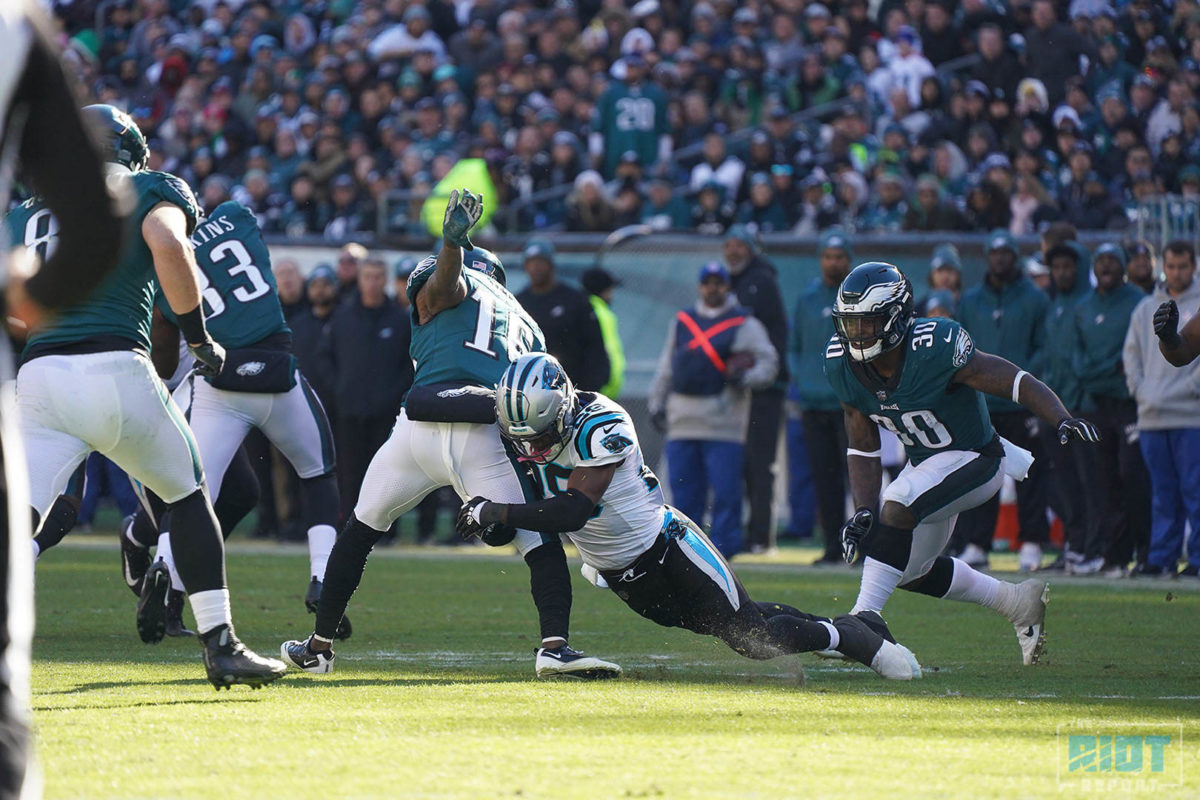RP-Ohs
RPOs have suddenly come into vogue in the NFL in the past couple of seasons after being staples of many college offenses over the past few years. The core concept is similar to a read-option, only rather than reading a defender to decide whether the hand off or to keep the ball for a QB run, the read is instead whether to hand the ball off or to throw the ball. This generally means that the read is of a second level defender, with the plan being to throw the ball over their head if they come down to stop the run. It is hard to tell precisely if a play is an RPO purely from tape, but if the following plays are not actually RPOs – but rather quick-hitting play-action passes – then the effect is the same regardless of how it is drawn up. So what does RPO defense come down to?
More than anything else this often comes down to good coverage, as if executed and designed well, it is very hard for the read defender to not be drawn down to stop the run – even if it is only for a moment – and so to stop the pass, the defense needs to be able to cover on the back end to increase the difficulty of the throw. James Bradberry does a good job of this on both of the following plays:
To be fair, there is a reason why these plays are suddenly in fashion; they are extremely hard to defend. On the following plays, the Panthers don’t actually do a bad job; the coverage is competent and they even get somebody in the face of the quarterback to hinder the throw – but the offense is still able to convert:
And sometimes you just get beaten by a really good throw and catch:
The only thing the Panthers could have done better on some occasions is to not allow such easy release into the middle of the field. The Panthers have tended to play with quite a lot of cushion thus far this season, and on in-breaking routes, that does mean that they are always going to have a hard time contesting the throw. Donte Jackson doesn’t really do anything wrong on the next play, but his starting position means he is always going to be little more than a spectator against the slant:
Sometimes these soft cushions go beyond non-ideal and actually start to be a real issue. On both of the following plays, the defenders start well off the line of scrimmage and so the receiver is able to create easy separation with a break back to the quarterback, allowing for quick and easy completions:
There are risks associated with playing closer to the line of scrimmage, but if teams are able to nickel and dime a defense on underneath routes, that’s going to make it tough to keep them from scoring. In fact, all of the following receptions are simply too easy, with the receiver in plenty of space for the quick throw. The run fake might make it easier to take away the help defender, but all of these are very open receivers:
And a hold never makes anything better:
It is hard to talk about these plays in terms of a pass rush, as the ball is often out too quickly for anybody to get pressure, but it should be noted that most of these attempts came in the Bengals and Falcons games, allowing the offense to pick up chunk plays through the air without having to rely on dropback passes. It is hard to get pressure when an offense isn’t forced to drop back in the pocket to complete throws, and a lot of what has limited the Panthers’ pass rush at times this season has had more to do with how open receivers have got within a second or two of the snap. Some of this is due to good play design, and some has to fall at the feet of the players themselves, but if the Panthers continue to play a lot of off-man coverage, they are always going to expose themselves to this kind of quick passing attack, something that got exposed quite a bit in the preseason and has continued into the regular season.
Neither of the Panthers’ consistent issues in terms of pass defense have actually been due directly to the pass rush, with the main culprits being player error and an over-use of certain coverages. What these plays have allowed for, however, is for opposing offenses to pick up passing yards and completions without exposing themselves to the Panthers’ pass rush. This is in part good offensive coaching, but the Panthers can’t allow for it to be this easy to pick up consistently good yardage against them. Of course, these plays are never going to make up the majority of an offense’s passing attack, so why have the Panthers’ been inconsistent in getting pressure the rest of the time?
Well for that, you’ll have to wait for part three…



